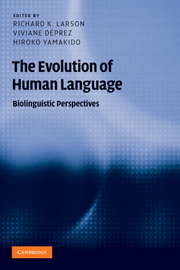Book contents
- Frontmatter
- Contents
- Figures
- Contributors
- Acknowledgments
- Introduction
- 1 The faculty of language: what is it, who has it, and how did it evolve?
- Part I Language architecture
- 2 Some simple evo devo theses: how true might they be for language?
- 3 Your theory of language evolution depends on your theory of language
- 4 Three meanings of “recursion”: key distinctions for biolinguistics
- 5 On obfuscation, obscurantism, and opacity: evolving conceptions of the faculty of language
- Part II Language and interface systems
- Part III Biological and neurological foundations
- Part IV Anthropological context
- Notes
- References
- Index
3 - Your theory of language evolution depends on your theory of language
Published online by Cambridge University Press: 05 June 2012
- Frontmatter
- Contents
- Figures
- Contributors
- Acknowledgments
- Introduction
- 1 The faculty of language: what is it, who has it, and how did it evolve?
- Part I Language architecture
- 2 Some simple evo devo theses: how true might they be for language?
- 3 Your theory of language evolution depends on your theory of language
- 4 Three meanings of “recursion”: key distinctions for biolinguistics
- 5 On obfuscation, obscurantism, and opacity: evolving conceptions of the faculty of language
- Part II Language and interface systems
- Part III Biological and neurological foundations
- Part IV Anthropological context
- Notes
- References
- Index
Summary
This paper is more about the questions for a theory of language evolution than about the answers. I'd like to ask what there is for a theory of the evolution of language to explain, and I want to show how this depends on what you think language is.
So, what is language? Everybody recognizes that language is partly culturally dependent: there is a huge variety of disparate languages in the world, passed down through cultural transmission. If that's all there is to language, a theory of the evolution of language has nothing at all to explain. We need only explain the cultural evolution of languages: English, Dutch, Mandarin, Hausa, etc. are products of cultural history.
However, most readers of the present volume probably subscribe to the contemporary scientific view of language, which goes beneath the cultural differences among languages. It focuses on individual language users and asks:
(Structure and acquisition of language competence) What is the structure of the knowledge that individual language users store in their brains, and how did they come to acquire this knowledge?
The question of acquisition leads to an important corollary question:
(Structure of capacity to learn language) What is the structure of the knowledge/ability in the child that makes language acquisition possible?
This latter knowledge is independent of what language the child actually learns in response to the environment. It is closer to what is generally called the language capacity (or the language instinct or universal grammar or the language acquisition device).
Information
- Type
- Chapter
- Information
- The Evolution of Human LanguageBiolinguistic Perspectives, pp. 63 - 72Publisher: Cambridge University PressPrint publication year: 2010
Accessibility standard: Unknown
Why this information is here
This section outlines the accessibility features of this content - including support for screen readers, full keyboard navigation and high-contrast display options. This may not be relevant for you.Accessibility Information
- 26
- Cited by
